Spring使用注解存储和读取对象
文章目录
- 一、存储Bean对象
-
- 配置扫描
- 添加注解存储Bean对象
- 注解使用范围
- Bean的命名
- 五大类注解的关系
- 为什么需要五大类注解?
- 二、方法注解@Bean
-
- Bean重命名
- 三、对象注入
-
- 属性注入
- Setter注入
- 构造方法注入
- @Autowired 和 @Resource 的区别
一、存储Bean对象

之前我们存储Bean时,需要在spring-config.xml中添加bean注册才行,这样的方式并不简单。我们要想更简单的存储和读取对象的核心是使用注解
1.使用类注解(五大类注解):
@Controller:控制器,验证用户请求的数据正确性(安保系统)
@Service:服务层,编排和调度具体执行方法的(客服中心)
@Repository:持久层,和数据库进行交互,等同于DAO(Data Access Object) 数据访问层
@Component:组件(工具类)
@Configuration:配置项(配置项目中的一些配置)
2.方法注解:
@Bean路径
配置扫描
要想将对象成功存储到Spring中,物品们需要配置一下存储对象的扫描包路径,只有被配置的包下的所有类,添加了注解才能被正确的识别并保存到Spring中,需要在spring-config.xnl添加如下配置:
<beans xmlns="http://www.springframework.org/schema/beans"
xmlns:xsi="http://www.w3.org/2001/XMLSchema-instance"
xmlns:content="http://www.springframework.org/schema/context"
xsi:schemaLocation="http://www.springframework.org/schema/beans http://www.springframework.org/schema/beans/spring-beans.xsd http://www.springframework.org/schema/context https://www.springframework.org/schema/context/spring-context.xsd">
<content:component-scan base-package="com.zd.demo">content:component-scan>
beans>

这步是十分重要的,要是不是在配置扫描包下的类对象,即使加了注解,也是不能存储到Spring中的
添加注解存储Bean对象
使用 @Controller 存储 bean 的代码如下所示:
@Controller //将对象存储到Spring中
public class StudentController {
public void hello() {
System.out.println("hello Im student");
}
}
读取StudentController对象
public static void main(String[] args) {
//得到Spring上下文
ApplicationContext context = new ClassPathXmlApplicationContext("spring-config.xml");
//得到bean
StudentController studentController =
context.getBean("studentController",StudentController.class);
//调用bean方法
studentController.hello();
}
@Service
public class StudentService {
public void hello() {
System.out.println("hello Im studentService");
}
}
获取Bean对象:
public static void main(String[] args) {
//得到Spring上下文
ApplicationContext context = new ClassPathXmlApplicationContext("spring-config.xml");
//得到bean
StudentService studentService =
context.getBean("studentService",StudentService.class);
//调用bean方法
studentService.hello();
}
注解使用范围
1.是否可以与component-scan一起使用?

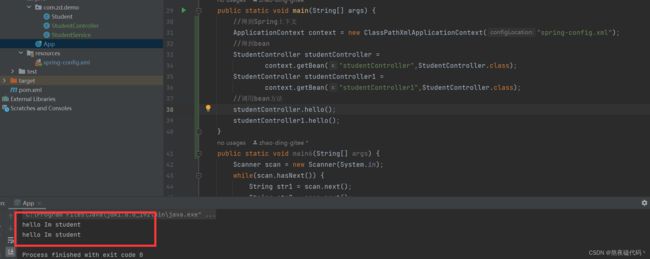
我们可以发现是可以一起使用的
2.五大类注解可以不再component-scan包下吗?
不可以
3.component-scan下的类,没有加五大类注解,可以存储到Spring吗?
不可以
4.componemt-scan下的所有子包下的类只要加了五大类注解,可以存储到Spring吗?
子包下的类只要加了五大类注解,同样可以存储到Spring中
Bean的命名

我们在获取Bean对象时,传入名称时,一般分为两种情况:
默认情况下:使用原类名首字母小写就能读取到Bean对象
特殊情况:原类名如果首字母和第二个字母都是大写的情况,那么使用原类名获取


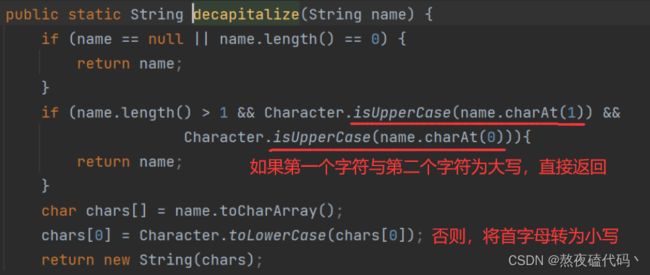
五大类注解的关系


可以认为@Controller / @Service / @Repository /@Configuration都是@Component的"子类",都是针对于@Component的一个扩展
为什么需要五大类注解?
我们可以发现,只要我们在类上加了注解,都可以获取到Bean对象,为什么需要这么多的类注解呢?
为了让程序员看到注解之后一眼就知道当前类的作用
JavaEE标准分层:
1.控制层(Controller)
2.服务层(Service)
3.数据持久层(Dao)

二、方法注解@Bean
五大类注解是添加到某个类上的,而方法注解是放到方法上的

我们首先准备一个实体类,然后使用方法注解@Bean将对象存储到Spring容器中
public class UserBeans {
@Bean
public static User getUser() {
User user = new User();
user.setUid(1);
user.setUsername("张三");
user.setPassword("123456");
return user;
}
}
然后从Spring容器中获取对象
public static void main(String[] args) {
ApplicationContext context =
new ClassPathXmlApplicationContext("spring-config.xml");
User user = context.getBean("user",User.class);
System.out.println(user);
}

我们发现使用的时候报错了,没有名为user的Bean对象,出现这种现象一共有两大原因:
1.@Bean命名规则与五大类注解的命名规则不同,@Bean命名规则,默认@Bean存储的对象名称 == 方法名

2.@Bean注解必须要搭配五大类注解一起使用(Spring为了提升性能所做的规定)
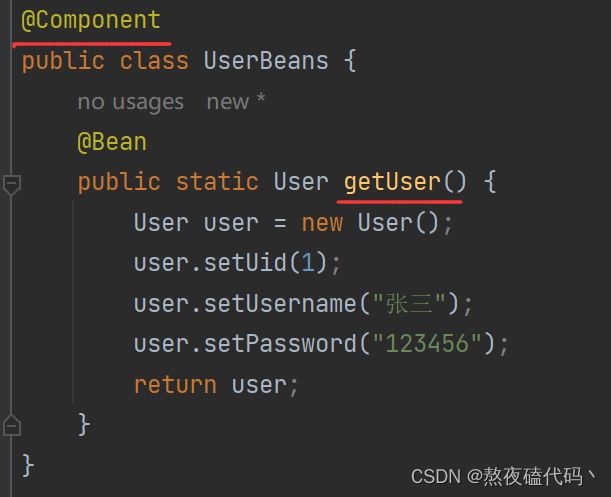

现在就可以正常获取到Bean对象了
Bean重命名
我们上述通过方法名获取Bean对象太抽象了,我们可以通过设置name属性给Bean对象进行重命名操作,如下述操作:
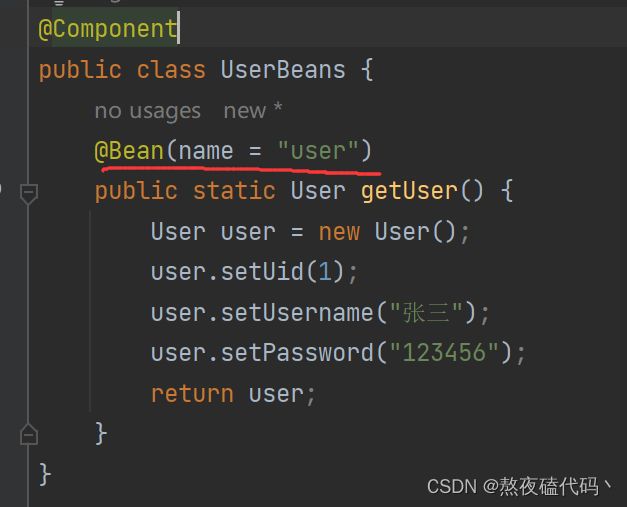
我们给Bean起一个user的名字

我们可以发现就可以通过这个重名获取了。
我们这里的重命名可以起多个名字,因为我们Spring容器中允许将同一类型的对象,存储到容器多份
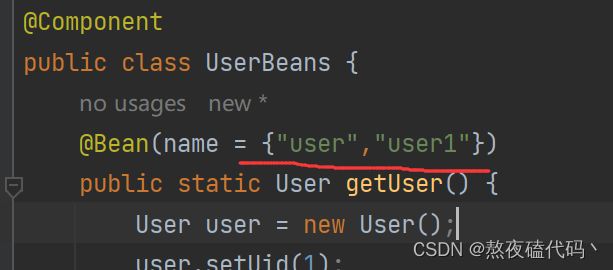
当@Bean使用了重命名之后,使用方法名是否还能获取到对象?
不能,当@Bean对象重命名之后,默认的使用方法名获取的方式就不能使用了

三、对象注入
获取Bean对象也称之为对象装配,就是将对象取出来放到某个类中,有时候也称之对象注入
对象注入的实现方法有以下三种:
1.属性注入
2.Setter注入
3.构造方法注入
属性注入
属性注入是使用@AutoWired注解实现的
@Component
public class Group {
@Autowired
private User user;
public User getUser() {
return user;
}
public void setUser(User user) {
this.user = user;
}
}

这样就可以实现属性注入了,虽然属性注入实现简单、使用简单,但它有以下缺点:

我么将鼠标放在注解上,会提示我们属性注入不推荐使用
1.无法注入一个不可变对象(final 修饰的对象)

final修饰的对象要么直接复制,要么在构造方法中赋值。放我们属性注入时,上述两种都不满足,所以就注入失败了
2.通用性,属性注入只能在IoC容器中使用,其他容器中不支持
3.违背单一设计原则。简单理解就是注入方式越简单,滥用的概率越大,出现违背单一职责的概率也越大
Setter注入
setter注入也是使用@Autowired注解实现
@Component
public class Group {
private User user;
@Autowired
public void setUser(User user) {
this.user = user;
}
public User getUser() {
return user;
}
}

我们使用Setter注入也可以成功存储取出,Setter注入符合单一职责的设计原理,但也有以下缺点:
1.不能注入不可变对象

2.注入的对象可能被修改,因为我们在任何事件都可以调用setXXX方法来改变注入的对象
构造方法注入
构造方法注入也是Spring官方推荐的注入方式:
public class Group {
private User user;
@Autowired
public Group(User user) {
this.user = user;
}
}

如果当前类只有一个构造方法的话,@Autowired注解可以省略


构造方法注入。有以下优点:
1.可注入不可变对象

2.注入对象不会被修改
构造方法在对象创建时只会执行一次,因为不存在注入对象被随时修改的情况
3.完全初始化
构造方法是在对象创建之前之前的,当我们使用被注入的对象时,会被完全初始化
4.通用性强
支持各种框架
@Autowired 和 @Resource 的区别
在进行类注入时,除了可以使用@Autowired关键字,我们还可以使用@Resource进行注入


@Autowired 和 @Resource 的区别:
1.出身不同:@Autowired是Spring的注解,@Resource是JDK的注解
2.查找顺序不同:@Autowired 先根据类型再根据名称查询,而 @Resource 先根据名称再根据类型查询
3.支持参数不同,@Autowired支持一个,@Resource支持7个


4.依赖注入支持不同:@Autowired支持三种注入,而@Resource只支持属性注入和Setter注入
当同一类型多个Bean时会报错


再去获取对象就会出错,非唯一的Bean的对象,因为我们Spring中有user1和user2,不知道注入那个,解决方案有两个:
1.使用@Resource(name = “XXX”)


2.使用@Qualifier注解定义名称,搭配@Autowired注解使用






